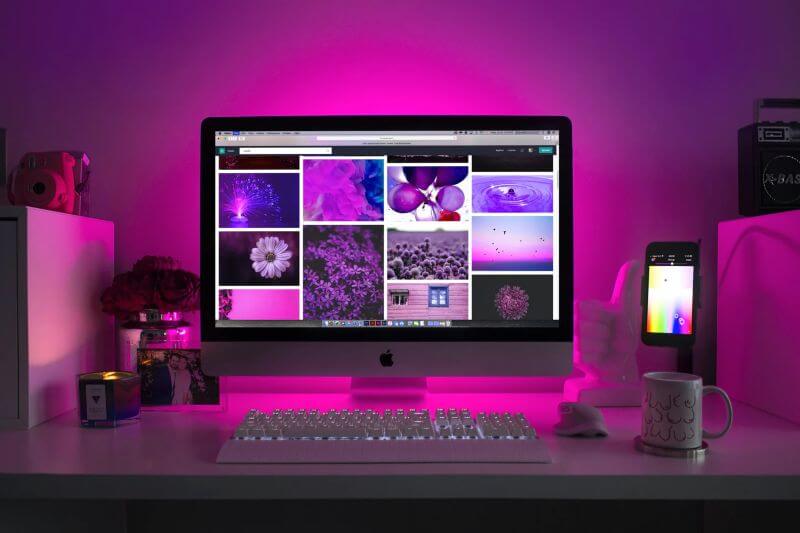
LED strip lights are more popular than ever, offering easy and affordable ways to add ambiance to a space, and with endless options for customization. One way to enhance the effects of LED strip lights is to understand and incorporate color psychology into your lighting design. Here, we explore the basics of color theory and psychology and how to involve them in order to create a specific "vibe" or aesthetic using LED lighting.
Using warmer colors like red or yellow create a cozy and welcoming feel to an area, while cooler colors like blue or green can induce a sense of relaxation and calmness. You can use LED light strips to set the exact mood you want by understanding and applying these fundamentals of color theory and psychology.
In addition to using color theory and psychology to create custom surroundings, there are other ways to customize the effect of LED strip lights. For example, dimmers can be included in order to adjust the intensity of the lights, or you can even use different wall patterns and textures to create visual appeal. With the right combination of color, intensity, and texture, you’ll be able to create a unique and personalized environment with LED strip lighting.
Color Theory and Color Psychology
Color theory is the study of how colors interact and ways they can be combined to create visual impact. There are three primary colors: red, blue, and yellow - colors that cannot be created by mixing others together. Secondary colors are green, purple, and orange - colors created by mixing two primary colors. Tertiary colors are ones created by mixing a primary and secondary color.
Color psychology is the study of a color’s effect on people's emotions and behavior and how different colors evoke different emotions and reactions from people. For example, red is often associated with passion, energy, and love, while blue is associated with trust, calmness, and serenity. The psychology of color is used in many fields, commonly marketing and advertising, to influence people's decision-making and behavior.

Red: Red is a warm color that is often associated with passion, love, and energy. It is an attention-grabbing and can increase heart rate and blood pressure. Red LED strip lights can be used to create a romantic and passionate ambiance in a bedroom or to increase energy and excitement in a workout room.
Blue: Blue is a cool color that is often associated with calmness, trust, and serenity. It is a soothing color that can lower heart rate and blood pressure. Blue LED strip lights can be used to create a calm and relaxing feel in a bedroom or to promote focus and productivity in a home office.
Green: Green is a cool and refreshing color that is often associated with nature, balance, and harmony. It is considered a calming color with the ability to reduce stress and anxiety. Green LED strip lights can be used to create a peaceful and relaxing aura in a meditation room or to promote harmony and balance in a yoga studio.
Orange: Orange is a vibrant and energetic color that can increase our appetite and motivation. It's a color often associated with enthusiasm, excitement, and warmth.
Yellow: Yellow is warm and cheerful, often associated with happiness, optimism, and creativity. It is a stimulating color that can increase mental clarity and energy levels. Yellow LED strip lights can be used to create a cheerful and inviting environment in areas like a living room or to promote creativity in an art studio.
Purple: Purple is a rich and luxurious color that is often associated with royalty, creativity, and spirituality. It’s a color that can promote creativity and inspiration and purple LED strip lights are often used to create a luxurious and elegant atmosphere in a dining room or to promote creativity and inspiration in an art studio.

White: White LED strip lights, unlike the direct output colors referenced above, produce a CCT or “correlated color temperature.” The contrast in color temperatures is measured in Kelvin, and the higher the Kelvin rating (written as “K”), the whiter the light will be.
Lower temperatures around the 2000K-3000K range, appear as warm colors, close to yellow and orange. These hues emulate the light seen during sunrise and sunset, so it’s not surprise that warm white LED strip lights emitting low color temperatures trigger the release of melatonin and makes us feel warm, relaxed and comfortable.
Higher temperatures (5000K or more) appear as cool colors such as blue and green. Toward midday, light increases in temperature. In accordance with our body’s circadian rhythm, higher color temperatures increase our concentration and make us feel more alert.
So, when it comes to using LED light strips, keep the psychology of color in mind and use it to create an atmosphere tailored to your preferences. When determining colors for your chosen space, do consider the emotions and reactions associated with them - complementary colors can help create a dynamic and visually appealing effect, while monochromatic colors bring a more harmonious effect.
Check out our collection of LED strip lights and don't hesitate to experiment with different tones until you find the perfect combination to fit your needs! A little color psychology paired with a bit of experimentation can enhance your space with distinctive and visually stunning lighting design guaranteed to make you happier and more comfortable.
